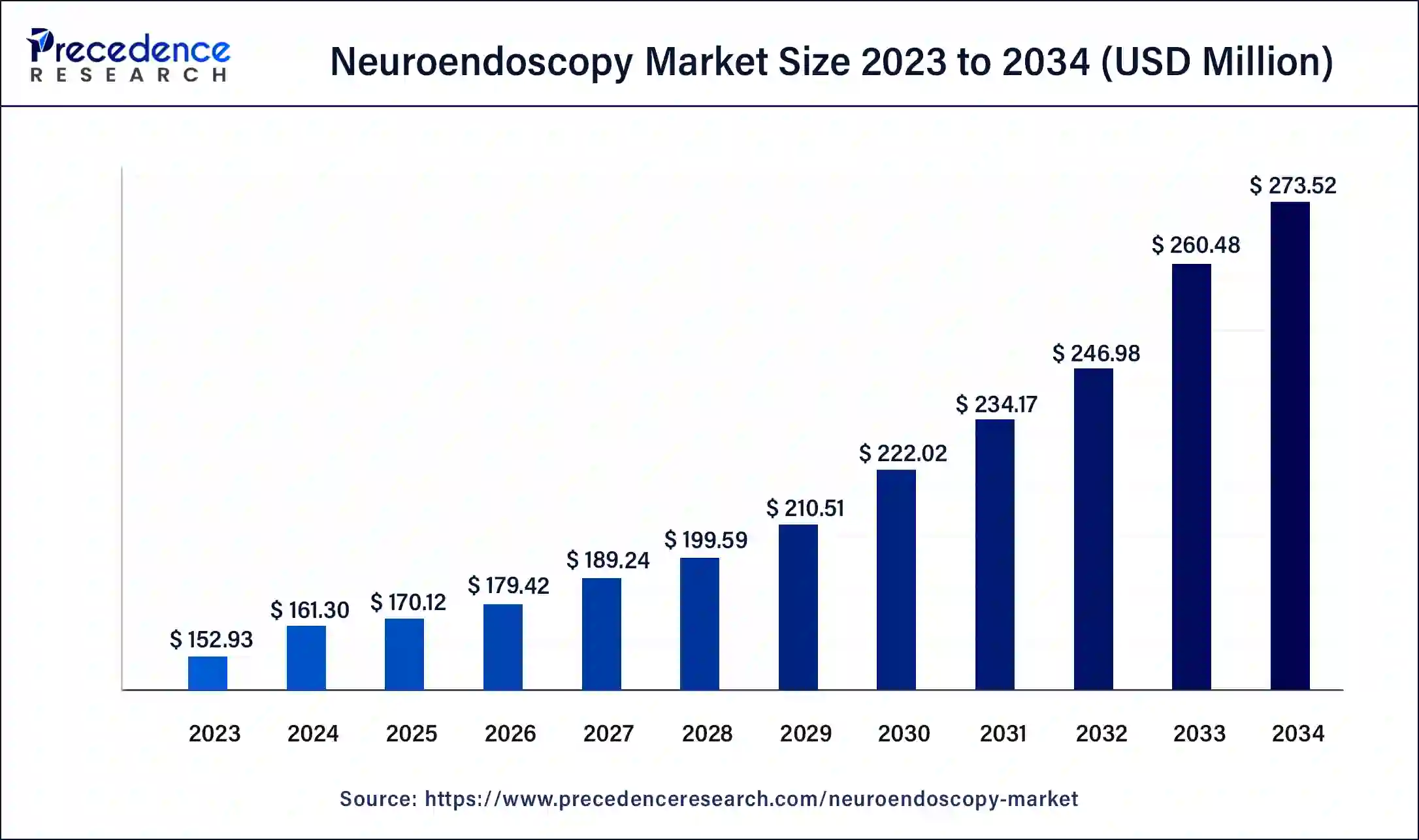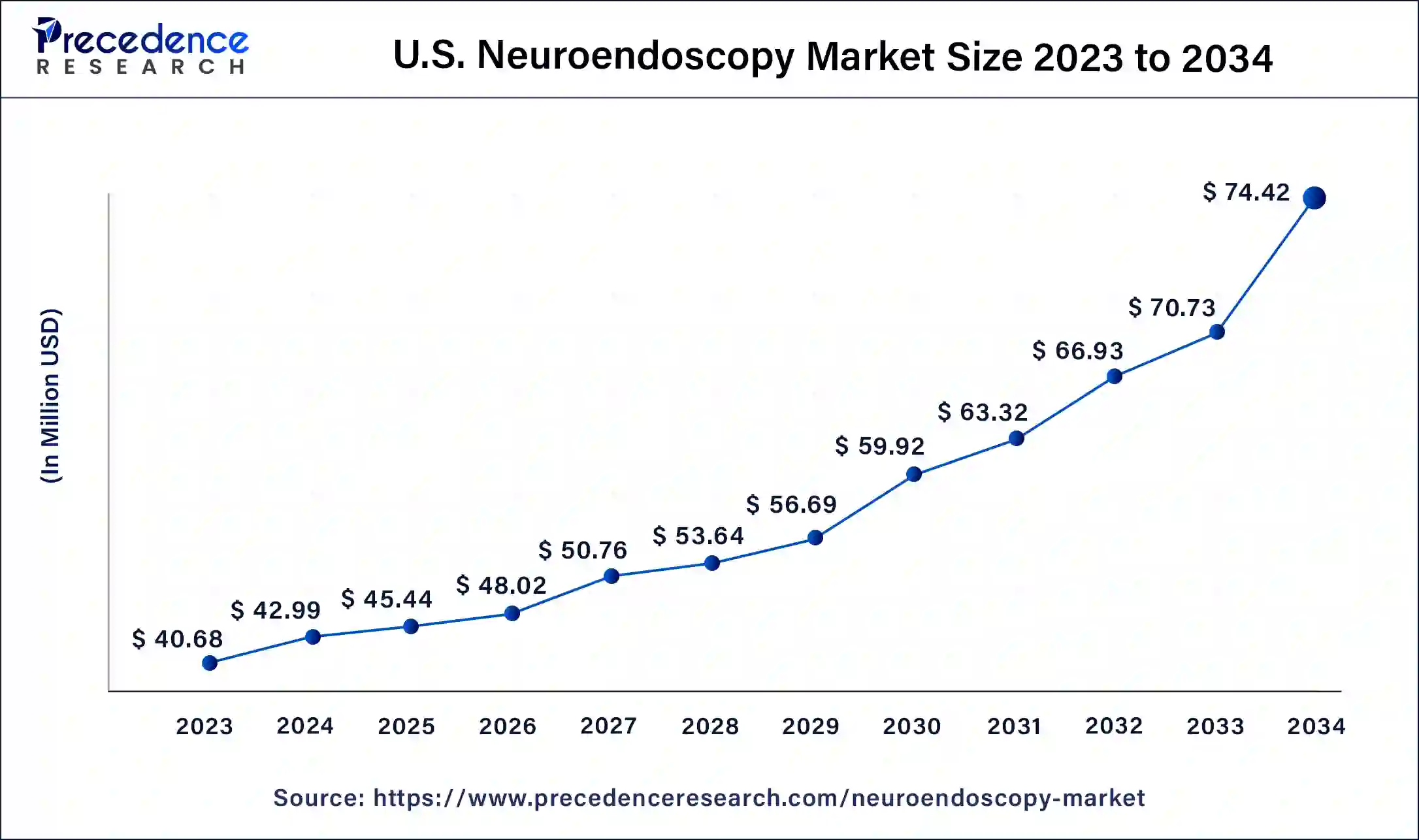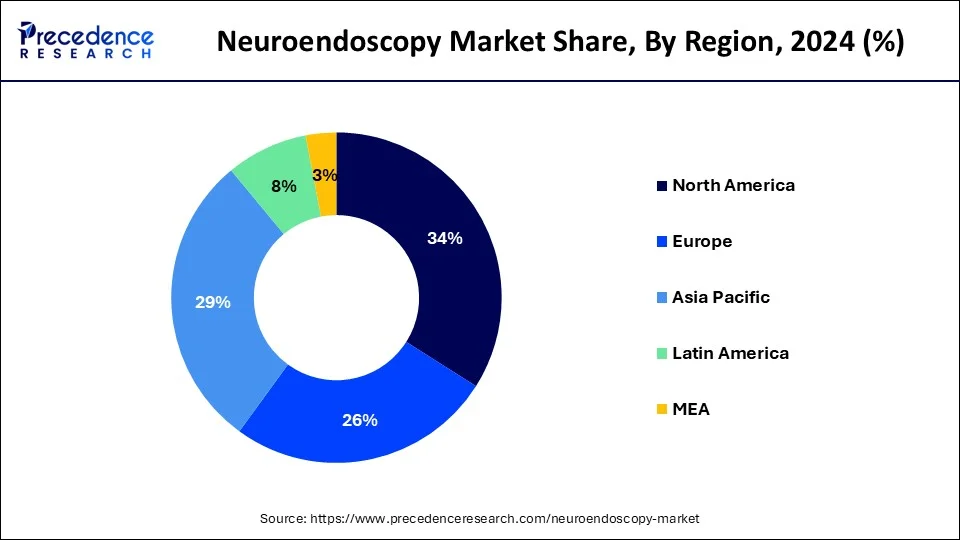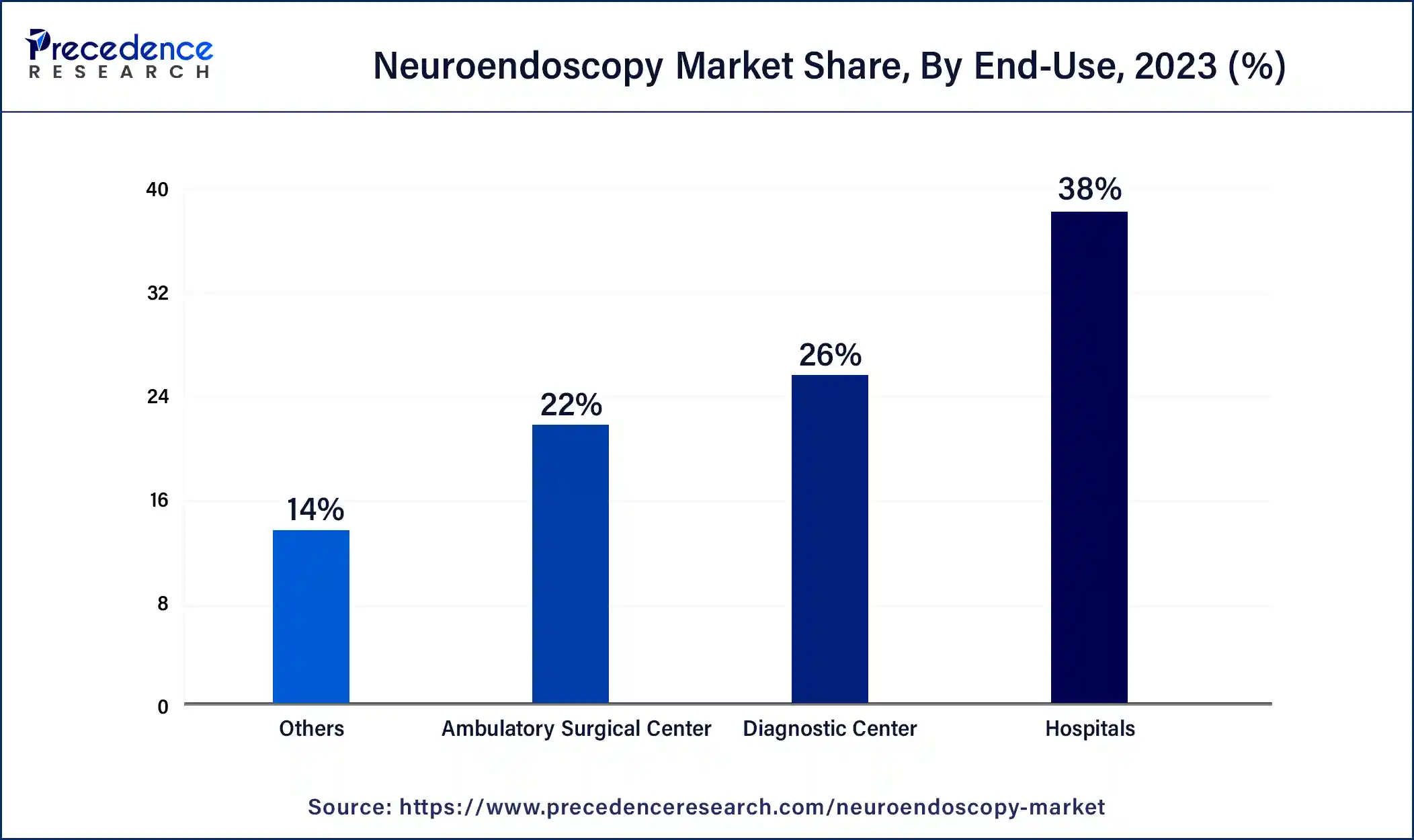List of Contents
Neuroendoscopy Market Size and Forecast 2025 to 2034
The global neuroendoscopy market size was calculated at USD 161.30 million in 2024 and is expected to reach around USD 273.52 million by 2034, expanding at a CAGR of 5.42% from 2025 to 2034. The neuroendoscopy market size reached USD 54.84 million in 2024. The rising prevalence of neurological disorders and technical advancements in neurosurgical operations are driving the neuroendoscopy market exponentially globally.

Neuroendoscopy Market Key Takeaways
- The global neuroendoscopy market was valued at USD 161.30 million in 2024.
- It is projected to reach USD 273.52 million by 2034.
- The neuroendoscopy market is expected to grow at a CAGR of 5.42% from 2025 to 2034.
- North America dominated the market with the biggest market share of 34% in 2024.
- Asia Pacific is the fastest-growing region in the market.
- By product, the rigid neuroendoscopes segment has held the largest market share of 68% in 2024.
- By usability, the reusable segment dominated the market with the biggest market share of 85% in 2024.
- By application, the intraventricular neuroendoscopy segment has held the major market share of 52% in 2024.
- By patient, the adult segment led the market with the maximum market share in 2024.
- Based on end-use, the hospital segment has contributed the major market share of 38% in 2024.
U.S. Neuroendoscopy Market Size Size and Growth 2025 to 2034
The U.S. neuroendoscopy market size was estimated at USD 42.99 million in 2024 and is predicted to be worth around USD 74.42 million by 2034 at a CAGR of 5.64% from 2025 to 2034.

North America dominated the neuroendoscopy marketdue to advancements in technology and a growing demand for minimally invasive neurological procedures. In the region, the United States and Canada are at the forefront of this expansion, with a strong emphasis on innovation and patient care. The region's market continues to proliferate, driven by innovation, expertise, and a commitment to advancing neurological care.
In the United States, neuroendoscopic procedures are widely performed for conditions such as brain tumors, hydrocephalus, and pituitary gland (a gland that is referred to as a regulatory system of the human mind and body) disorders. Advanced imaging systems and surgical techniques contribute to improved outcomes and lesser recovery times for patients undergoing neuroendoscopic interventions.
Similarly, in Canada, neuroendoscopy is gaining popularity, with specialized centers offering a wide range of procedures, from minimally invasive tumor resections to endoscopic treatment of hydrocephalus. Canadian healthcare providers are leveraging cutting-edge technology to deliver high-quality care to patients across the country.

Asia-Pacific is the fastest-growing region of the neuroendoscopy marketand is experiencing significant growth owing to the highest population rate. Countries like Japan, China, and India are witnessing a rise in neuroendoscopic procedures, driven by increasing healthcare infrastructure and demand for minimally invasive treatments. The region's market is driven by the increasing adoption of advanced techniques and equipment, improving patient outcomes across the region. And it is expected to thrive further in the foreseen period.
- In Japan, advancements in neuroendoscopic technology have led to the development of high-resolution imaging systems, enhancing surgical precision for procedures such as tumor resections and hydrocephalus treatment. China's expanding healthcare sector has seen a surge in neuroendoscopic surgeries, particularly for conditions like intracranial cysts and pituitary tumors. This growth is supported by investments in medical research and infrastructure.
- In India, neuroendoscopy is becoming more accessible, with specialized centers offering a range of procedures, such as hydrocephalus and endoscopic transsphenoidal surgery for pituitary tumors. India has its neuroendoscopy society, which was established in 2013 and is known as NESI.
Market Overview
The neuroendoscopy market is a field in medicine that deals with using small cameras and tools to diagnose and treat conditions in the brain and nervous system. It's like a mini surgery that allows doctors to see inside the brain without making big incisions. This market is growing because more doctors and patients realize the benefits of less invasive procedures. Neuroendoscopy can be used to treat conditions like brain tumors, hydrocephalus (fluid buildup in the brain), and certain types of epilepsy. It's becoming more popular because it often leads to shorter hospital stays, faster recovery times, and fewer complications compared to traditional surgery. As technology improves, neuroendoscopy procedures are becoming even more precise and effective.
- Additionally, as more people learn about its advantages, the demand for these procedures is increasing. Overall, the neuroendoscopy market is expected to keep growing as more innovations come along and more patients opt for these less invasive treatments.
Neuroendoscopy Market Growth Factors
- Continuous improvements in neuroendoscopic equipment and techniques are driving growth by making procedures safer, more precise, and less invasive.
- The rising incidence of conditions such as brain tumors, hydrocephalus, and epilepsy are fueling demand for neuroendoscopic procedures as they offer effective treatment options with fewer risks.
- Education and awareness initiatives are enhancing understanding of the benefits of neuroendoscopy, leading to greater adoption of these procedures.
- Improved insurance coverage for neuroendoscopic procedures is encouraging more patients to seek treatment, thus boosting market growth.
- With the aging population, there is a higher likelihood of neurological disorders, driving the need for neuroendoscopic interventions.
- Increasing preference for minimally invasive procedures among patients and surgeons is propelling the demand for neuroendoscopy, as it offers shorter recovery times and reduced post-operative complications compared to traditional open surgeries.
Neuroendoscopy Market Scope
| Report Coverage | Details |
| Market Size by 2034 | USD 273.52 Million |
| Market Size in 2025 | USD 170.12 Million |
| Market Size in 2024 | USD 161.30 Million |
| Growth Rate from 2025 to 2034 | CAGR of 5.42% |
| Largest Market | North America |
| Base Year | 2024 |
| Forecast Period | 2025 to 2034 |
| Segments Covered | Product, Usability, Patient, Application, End-Use, and Region |
| Regions Covered | North America, Europe, Asia-Pacific, Latin America, and Middle East & Africa |
Market Dynamics
Driver
Increasing prevalence of neurological disorders
A significant driver contributing to the growth of the neuroendoscopy market is the increasing prevalence of neurological disorders. As the incidence of conditions such as brain tumors, hydrocephalus, and epilepsy continues to rise, there is a growing demand for effective treatment options. Neuroendoscopic procedures offer a minimally invasive approach to diagnosing and treating these disorders, making them increasingly attractive to both patients and healthcare providers.
Additionally, the aging population is driving the need for neuroendoscopic interventions. With a larger proportion of elderly individuals in the population, there is a higher likelihood of developing neurological conditions that require medical intervention. Neuroendoscopy provides a less invasive alternative to traditional open surgeries, making it particularly appealing for older patients who may be at higher risk for complications.
Restraint
High cost
A significant restraint in the neuroendoscopy market is the high cost associated with equipment and procedures. The specialized instruments and advanced imaging technology required for neuroendoscopic procedures can be expensive to procure and maintain. Additionally, the training and expertise needed to perform these procedures further add to the overall cost. This high cost can act as a barrier to entry for healthcare facilities, particularly in regions with limited financial resources or where reimbursement rates are low.
Moreover, the potential risks and complications associated with neuroendoscopic interventions, although generally lower than traditional open surgeries, can still deter some patients and healthcare providers from pursuing this treatment option. Concerns about adverse events such as bleeding, infection, or nerve damage may influence decision-making and limit the widespread adoption of neuroendoscopy.
Opportunity
Expansion of the capabilities of neuroendoscopy
A significant opportunity in the neuroendoscopy market lies in the expanding application of neuroendoscopic techniques beyond traditional indications. While neuroendoscopy has long been used for procedures such as tumor resection and hydrocephalus treatment, there is growing interest in exploring its potential for a wider range of neurological conditions.
Neuroendoscopic procedures are being investigated for the treatment of movement disorders like Parkinson's disease, which is mostly found in older people—and essential tremor, and for managing certain psychiatric conditions such as obsessive-compulsive disorder (OCD). Additionally, there is ongoing research into the use of neuroendoscopy for accessing deep-seated structures in the brain for targeted drug delivery and neuromodulation therapies.
Advancements in technology and technique continue to expand the capabilities of neuroendoscopy, making it possible to address increasingly complex neurological disorders with greater precision and efficacy. As our understanding of the brain and nervous system improves, the potential applications of neuroendoscopy are likely to expand further, creating new opportunities for innovation and growth in the neuroendoscopy market globally.
Product Insights
The rigid neuroendoscopes segment held the largest share in neuroendoscopy market in 2024. The growth of this segment is attributed to the fact that these machines provide direct visualization of the affected area of the body when it passes through a small portion of the body. This segment is further divided into rigid neuroendoscopes and flexible neuroendoscopes.
There are two types of rigid neuroendoscopes: rigid fiberscopes and rigid videoscopes. These can be used as per the requirement and health condition of a patient under the observation of medical professionals. These provide benefits, such as high-quality images and videos of affected regions in the body, better control over the use of endoscopes, and access to deeper areas that would be ignored otherwise due to lack of reach.
Rigid endoscopes can provide sufficient space for various other surgical instruments, thereby providing more durability. Thus, these products can be used frequently on several patients, and sterilization is also a major benefit of rigid neuroendoscopy products.
Usability Insights
The reusable segment dominated the neuroendoscopy market in 2024.The usability segment is further subdivided into reusable and disposable endoscopes in the market. The growth of the reusable segment can be related to the minimal invasiveness of the procedure it provides and the subtle diagnosis of ailments. The reusable neuroendoscopy segment refers to neuroendoscopy market that involves the development and sale of instruments and equipment designed for multiple uses.
Instruments, such as endoscopes and associated tools, are tailored from durable materials that allow them to be sterilized and safely reused across multiple procedures. This approach offers cost-effectiveness and sustainability as compared to disposable endoscopes. Reusable neuroendoscopy equipment undergoes deep-rooted cleaning and sterilization processes to ensure patient safety. It's a significant aspect of the neuroendoscopy market. Which helps provide reliable tools for diagnosing and treating various neurological conditions.
Application Insights
The intraventricular neuroendoscopy segment held the largest revenue in the neuroendoscopy market globally.Based on the application segment, it is further subdivided into transnasal, intraventricular, and transcranial endoscopy. Among these, intraventricular is mostly used in endoscopy by medical professionals. The higher growth of this segment is associated with the rising prevalence of neurological dysfunctions, including brain tumors and neurodegenerative diseases mostly found in elderly people.
Intraventricular neuroendoscopy is a technique used in the field of neuroendoscopy where a tiny camera is inserted into the ventricles of the brain through a small incision or gap. This allows doctors to visualize and diagnose conditions inside the brain, such as tumors or blockages, without the need for traditional open surgery. It's like having a miniaturized camera explore the inner workings of the brain, providing valuable insights for treatment planning. Therefore, owing to the provision of such keen details of brain functions and nerves through intraventricular endoscopy, it is expected to hold its dominance for a longer period in the forecasted years.
Patient Insights
The neuroendoscopy market was dominated by the adult segment in 2024. The growth of this segment is associated with the rising geriatric population that is more prone to neurological disorders due to the age factor, and thus, they require frequent visits to healthcare professionals.
The adult segment of the neuroendoscopy market deals with procedures and devices tailored specifically for treating neurological conditions in adults. This includes a wide range of disorders like brain tumors, hydrocephalus, which means excess fluid in the brain, and pituitary gland issues. Due to such an advanced noninvasive procedure, the adult segment held the largest share of the market.
End-use Insights
The hospital segment dominated the market in 2024, and it is expected to further expand due to its higher significance across the globe. The hospital segment of the neuroendoscopy market can be defined as hospitals' primary purchasers and users of neuroendoscopic procedures and equipment. Hospitals dominate this segment for several reasons, including the fact that hospitals generally have advanced facilities and infrastructure necessary for performing neuroendoscopic procedures safely and effectively. This includes specialized operating rooms, imaging equipment, and skilled medical staff.
Neurosurgeons and other specialists working in hospitals have extensive expertise and experience in performing neuroendoscopic procedures. This expertise attracts patients seeking high-quality care for complex neurological conditions. Moreover, Hospitals often receive referrals from primary care physicians and other healthcare providers for patients requiring neuroendoscopic interventions. This consistent patient flow contributes to the dominance of hospitals in the market.

Hospitals frequently engage in research and innovation in the field of neuroendoscopy, leading to the development of new techniques, devices, and treatments. This continuous innovation enhances the hospital's reputation and further strengthens its dominance in the market. Hence, the segment dominates the neuroendoscopy market because it offers comprehensive neurological care, advanced facilities with experienced medical professionals, and an appealing environment for research and innovation in the endoscopy field.
Neuroendoscopy Market Companies
- Foncepi Comercial Exportadora Ltd
- B. Braun
- Karl Storz
- Olympus Corporation
- Stryker
- Medtronic
- Ackermann Instruments GmbH
- Adeor Medical AG
- Clarus Medical LLC
- Machida Endoscope
- Tonglu WANHE Medical Instrument
- Hawk
- Schindler Endoskopie Technologie GmbH
Recent Developments
- In September 2023, Amrita Hospital, Kochi, India, launched an advanced center of neuroendoscopy. It's known as the ACNE-Amrita Center for Neuroendoscopy. This launch will help India strengthen its position in the neuroendoscopy market globally.
- In August 2022, a group of U.S. scientists proved neuroendoscopy procedures to be one of the best options of treatment for patients suffering from brain abscesses with remarkable results.
Segments Covered in the Report
By Product
- Rigid Neuroendoscopes
- Flexible Neuroendoscopes
By Usability
- Reusable Neuroendoscopes
- Disposable Neuroendoscopes
By Patient
- Adult
- Pediatric
By Application
- Transnasal Endoscopy
- Intraventricular Endoscopy
- Transcranial Endoscopy
By End-Use
- Hospitals
- Ambulatory Surgical Center
- Diagnostic Center
- Others
By Geography
- North America
- Europe
- Asia-Pacific
- Latin America
- Middle East and Africa
For inquiries regarding discounts, bulk purchases, or customization requests, please contact us at sales@precedenceresearch.com
Frequently Asked Questions
Ask For Sample
No cookie-cutter, only authentic analysis – take the 1st step to become a Precedence Research client
 sales@precedenceresearch.com
sales@precedenceresearch.com
 +1 804 441 9344
+1 804 441 9344